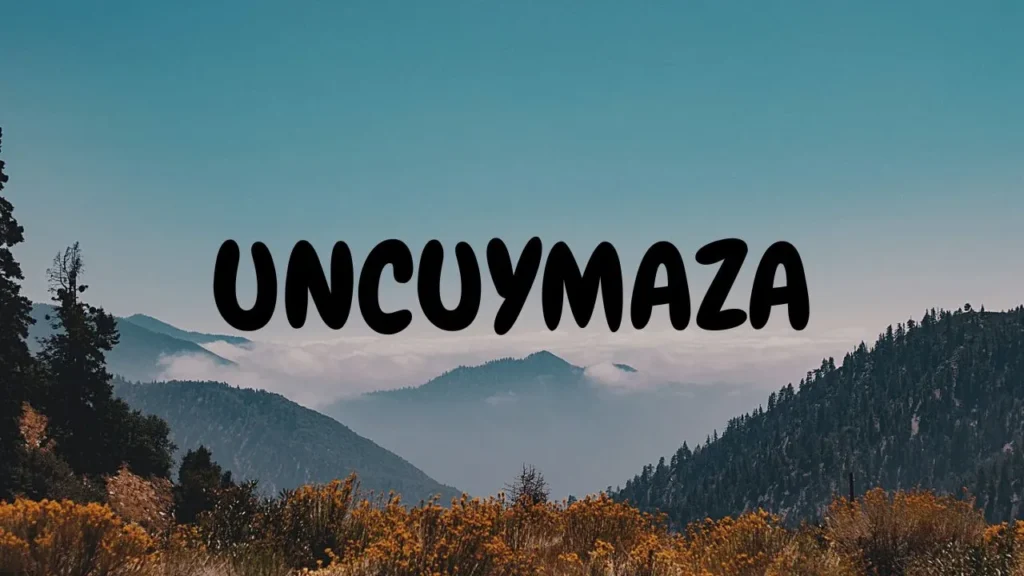In today’s fast-paced, ever-evolving world, few names resonate with the same uniqueness and intrigue as Uncuymaza. Whether it’s a name tied to cultural heritage, a creative movement, or a term rich with historical significance, Uncuymaza stands out as a topic worthy of exploration. The journey of Uncuymaza takes us across various domains—from cultural origins to its modern-day applications and influence. In this blog, we will take a deep dive into the world of Uncuymaza, uncovering its roots, its evolution, and why it remains a topic of fascination across different spheres.
Introduction: What is Uncuymaza?
Uncuymaza is more than just a word; it is a term steeped in cultural and possibly mythological origins, capturing the imagination of many. Over the years, Uncuymaza has come to represent a variety of concepts depending on the context in which it is used. In some traditions, it may symbolize heritage and continuity, while in others, it may stand for creativity and the unyielding spirit of innovation.
In recent years, Uncuymaza has become a point of interest not only for historians and cultural scholars but also for individuals in creative fields who seek to understand its significance. As we peel back the layers of its meaning, we begin to understand that Uncuymaza is not merely a static term but an evolving concept that continues to grow in importance.
The Origins of Uncuymaza
Every term or concept has an origin story, and Uncuymaza is no different. Its roots can be traced back to ancient times, with various communities and cultures attributing different meanings to it. Some scholars argue that Uncuymaza is tied to early mythologies or legends, with symbolic meaning linked to endurance, strength, or wisdom. Others see it as a concept born out of the necessity for preservation—whether of culture, land, or art.
There is also speculation that Uncuymaza was initially a geographical term, perhaps referencing a specific place known for its resources or significance in trade. This idea connects the term to historical narratives that speak of kingdoms and communities rising due to their geographical advantages. However, as cultures evolved and languages developed, the term Uncuymaza began to take on broader meanings, transitioning from something concrete into something more abstract, symbolizing the endurance of culture and the human spirit.
The Evolution of Uncuymaza Over Time
As Uncuymaza moved through history, it didn’t remain tethered to one meaning or purpose. Instead, like many other cultural symbols, it evolved. Over centuries, the term took on new layers of meaning, shifting from a specific geographic or cultural marker to a term more widely used to represent resilience, creativity, and adaptation.
During the Middle Ages, for instance, Uncuymaza may have represented the resistance of certain communities to external forces, be they political or social. In this context, the term symbolized an unbreakable spirit, the will to survive, and the adaptability needed to navigate changing landscapes.
In the context of art, Uncuymaza became associated with innovation and originality. Artists and creators began to draw inspiration from the term, using it to symbolize the uncharted territories of creative thought and expression. Whether in painting, sculpture, or design, Uncuymaza was invoked to represent the daring act of breaking away from tradition while honoring the past.
Uncuymaza in Modern Culture
Today, Uncuymaza continues to play a significant role in various cultural and artistic expressions. It has become a term that encompasses not only historical and geographical meanings but also modern interpretations. In the world of art and design, Uncuymaza is often used as a metaphor for pushing creative boundaries and embracing innovation. Many modern artists see Uncuymaza as a guiding principle, encouraging them to step beyond the familiar and explore new avenues of expression.
In literature, Uncuymaza has found its place as a symbol of endurance. Writers use the term to explore themes of survival, whether personal, communal, or environmental. It has been employed to discuss the human spirit’s ability to overcome adversity and find beauty and meaning in struggle.
In addition, Uncuymaza is increasingly being referenced in the fields of environmental conservation and sustainability. As the world grapples with the challenges of climate change and resource depletion, Uncuymaza has come to symbolize the importance of preservation—of both nature and culture. Environmentalists have embraced the term to advocate for the protection of ecosystems, suggesting that just as Uncuymaza represents resilience and adaptation, so too must humanity adapt to the realities of a changing planet.
The Role of Uncuymaza in Creative Movements
In the realm of creativity, Uncuymaza has become a source of inspiration for many. Creative individuals and collectives alike have adopted the term to symbolize their willingness to innovate and challenge the status quo. It is not uncommon to see Uncuymaza referenced in artistic manifestos, where it serves as a rallying cry for those seeking to make a lasting impact on the world of art, music, or performance.
One of the most compelling aspects of Uncuymaza in creative contexts is its ability to bridge the gap between tradition and modernity. While Uncuymaza encourages innovation, it does not advocate for the abandonment of the past. Rather, it seeks to integrate historical influences into contemporary work, creating a dialogue between what has been and what is yet to come.
For designers, Uncuymaza represents the intersection of form and function. It is a reminder that design is not only about aesthetics but also about solving real-world problems. In this sense, Uncuymaza pushes designers to think critically about the social, cultural, and environmental impact of their work.
Uncuymaza as a Symbol of Resilience
At its core, Uncuymaza is a symbol of resilience. Whether in the context of personal growth, artistic creation, or cultural preservation, the term evokes a sense of strength and continuity. It serves as a reminder that no matter how much the world changes, certain principles—such as the need for adaptation, innovation, and perseverance—remain constant.
This idea of resilience is particularly relevant in today’s world, where individuals and communities face unprecedented challenges. Whether it’s navigating the complexities of a global pandemic, dealing with the effects of climate change, or responding to social and political upheaval, the message of Uncuymaza is clear: resilience is key to survival and progress.
Uncuymaza and Environmental Conservation
As mentioned earlier, Uncuymaza has become an important symbol in the field of environmental conservation. Its meaning has expanded to encompass the idea of preserving not just cultural artifacts but natural ecosystems as well. In this context, Uncuymaza represents the delicate balance between human activity and the environment, urging individuals and organizations to take action in protecting the planet for future generations.
Environmental activists have embraced Uncuymaza as a call to action, using it to promote sustainable practices and advocate for the preservation of endangered species and habitats. The term has become a symbol of hope in the face of ecological destruction, reminding people that resilience and adaptation are necessary not just for individual survival but for the survival of the planet as a whole.
Conclusion: The Enduring Legacy of Uncuymaza
In conclusion, Uncuymaza is a term rich with meaning, history, and cultural significance. From its early origins to its modern-day applications, Uncuymaza has evolved into a powerful symbol of resilience, creativity, and preservation. Whether it’s used in the context of art, literature, design, or environmental conservation, Uncuymaza continues to inspire and guide those who seek to make a lasting impact on the world.
As we look to the future, the legacy of Uncuymaza will undoubtedly continue to grow. In a world that is constantly changing, the principles embodied by Uncuymaza—adaptation, innovation, and resilience—are more relevant than ever. By embracing these principles, we can not only survive but thrive, ensuring that the spirit of Uncuymaza lives on for generations to come.
FAQs About Uncuymaza
1. What is Uncuymaza?
Uncuymaza is a unique term that symbolizes resilience, innovation, and the fusion of tradition with modernity. It has historical and cultural significance and is often used in the context of creativity, environmental conservation, and personal growth.
2. Where did the concept of Uncuymaza originate?
The origins of Uncuymaza are deeply rooted in ancient cultures and mythology, with various communities attributing different meanings to it, such as resilience, continuity, and adaptation.
3. How is Uncuymaza relevant in modern times?
In modern culture, Uncuymaza represents innovation, sustainability, and the human spirit’s ability to endure and adapt to challenges. It is used in art, design, environmental conservation, and personal growth discussions.
4. How is Uncuymaza used in art and design?
Uncuymaza is a guiding principle for many artists and designers, symbolizing the balance between tradition and innovation. It encourages pushing creative boundaries while respecting historical influences.
5. Why is Uncuymaza important for environmental conservation?
Uncuymaza symbolizes the need to preserve both cultural heritage and natural ecosystems. It encourages sustainable practices, highlighting the importance of protecting the environment for future generations.







